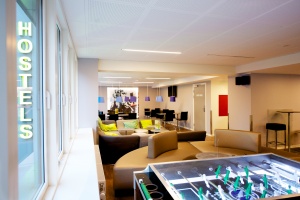The Hitchhiker’s Guide to Hostels
 Generator Hostels have been a recent success in the market
Generator Hostels have been a recent success in the market Youths are on the move, according to The Youth Travel Accommodation Industry Survey by industry body Stay Wyse.
It found that the global youth tourism market has grown at a steady rate since 2005, when there was an estimated worldwide market of around 160 million international youth tourism trips.
By 2011, this figure had grown to around 196 million, up three per cent on 2010, accounting for roughly 20 per cent of global tourism.
With travel becoming less expensive, especially for short-haul flights, international youth tourism is forecast to increase by approximately 100 million trips by 2020, according to the United Nations World Tourism Organisation.
In addition to the youth travel market, hostel operators are also increasingly targeting 25- to 34-year-old travellers.
Those who fall into this category are well-educated, adventurous and upwardly mobile.
The “flashpackers” among them are technologically sophisticated, mindful of fashion and design, socially aware and environmentally conscious.
As the label would suggest, they tend to have more disposable income and therefore a larger budget to spend on hostel accommodation.
With travel becoming easier, guest expectations have grown, placing considerable pressure on hostel operators.
Many now boast upgraded facilities, such as personal power sockets and individual lockers, as something of a standard. However, a minority of operators are pushing conventional boundaries to a more interesting extreme.
In much the same way as Schrager and Starck revolutionised the hotel sector in the late 1980s, brands such as Generator Hostels and Equity Point Youth Hostels are redefining the consensus.
Their hostels are typically characterised by a shared emphasis on social interaction, design, contemporary aesthetics, modern facilities and a strong brand identity.
To such an extent, some commentators have taken to using labels such as “five-star”, “designer” or “boutique” when referring to what is a budget-oriented product.
However, it is not just the larger hostel chains that are moving in this direction, but up-and-coming brands such as PLUS and ONE80˚ Hostels.
Supply & Demand
In determining the supply and demand of hostels in key European cities, research by CBRE Hotels focused on a mix of established and potential growth markets, including London, Paris, Berlin, Hamburg, Copenhagen, Dublin and Amsterdam.
At first glance, London appeared to be the most developed hostel market in the sample, with approximately 136 hostels, compared with 111 in Berlin and 56 in Amsterdam.
Most hostels in London (around 57 per cent) were located within Zone One, typically around Bayswater and Paddington, with a further 22 per cent located in Zone Two.
There are still a high number of independently operated hostels, with fewer than half belonging to a branded hostel chain.
With approximately 15 players in the market, this included traditional brands such as YHA as well as, to a lesser extent, modern operators such as Clink and Palmers Lodge.
Although London had the highest number of hostels in the CBRE sample, owing to the lower number of beds per property, it shared top spot with Berlin with around 17,600 beds.
This is particularly interesting considering that Berlin is not a top-ten destination city in Europe.
London, on the other hand, is the most popular city for overseas travellers, with 16.9m visitors as at Q2 2012 (MasterCard Global Destination Cities Index).
CBRE Hotels’ research suggested that, of the two cities, Berlin was the more established hostel market. It also hinted at the potential opportunity for future growth in London and further brand consolidation.
Similarly, Paris proved an insightful case study.
In much the same way that London is a popular tourist destination, Paris is a magnet for travellers, with 16m overseas visitors as at Q2 2012.
However, by comparison with London and Berlin, it had a much smaller hostel market, with approximately 40 hostels (5,700 beds).
This was behind Amsterdam (6,600 beds) and Dublin (6,000 beds), and slightly ahead of Copenhagen and Hamburg
Not only was Paris undersupplied in terms of the number of hostel beds relative to the size of its tourism market, there were relatively few branded operators in the city.
With the exception of St Christopher’s Inn Paris, fewer still could be classified as “flashpacker” friendly.
Conclusion
According to CBRE Hotels’ research, the hostel market in Europe presents an interesting opportunity for real estate investors and one that is well worth exploring.
Considering the growth in international youth tourism, there is a notable lack of hostel accommodation in key European cities. Furthermore, there are relatively few quality branded hostel chains, not least that have a pan-European presence.
In light of changing consumer trends, those that venture into this market and best understand the interplay between supply and demand should be well placed to reap the rewards.
Article by Nicholas Worsley, CBRE Hotels EMEA

